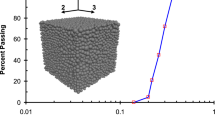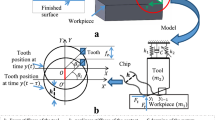Abstract
Although much technological advancement has been implemented in the aluminum extrusion industry, there are still considerable expenses as tests of different process parameters or new die geometries are carried out. To reduce the amount of trial-and-error testing, it is important to understand the process variation as each parameter or piece of equipment changes. Therefore, this work performed and analyzed the numerical simulation of aluminum extrusion using the finite element method through the COMSOL® Multiphysics software. A visco-plastic modeling approach was used, where the solid, aluminum, is treated as a high viscosity fluid. Furthermore, in order to optimize the process parameters and understand the physical behavior of the problem, a metamodel was built using a quadratic response surface model and, from this, a mono and multiobjective optimization was performed using the Lichtenberg algorithm metaheuristic. The multiobjective optimization with the metamodel resulted in errors of 0 to 2% in relation to the actual response.






















Similar content being viewed by others
Availability of data and materials
The data in this manuscript is available from the corresponding author on reasonable request.
Code availability
Not applicable.
Abbreviations
- CAE:
-
Computer-aided engineering
- DOE:
-
Design of experiments
- FEM:
-
Finite element method
- FVM:
-
Finite volume method
- MEP:
-
Multiport extrusion
- ALE:
-
Arbitration Lagrangian–Eulerian
- CVD:
-
Chemical vapor deposition
- SPRING:
-
Multiobjective Lichtenberg algorithm
- RSM:
-
Response surface methodology
- TOPSIS:
-
Technique for Order Preference by Similarity to Ideal Solution
References
Bakhtiani T, El-Mounayri H, Zhang J (2014) Numerical simulation of aluminum extrusion using coated die. Mater Today: Proceed 1(1):94–106. ISSN 2214–7853. https://doi.org/10.1016/j.matpr.2014.09.018
Bastani AF, Aukrust T, Brandal S (2011) Optimisation of flow balance and isothermal extrusion of aluminium using finite-element simulations. J Mater Process Technol 211(4):650–667. https://doi.org/10.1016/j.jmatprotec.2010.11.021 (ISSN 0924-0136)
Comsol Multiphysics Comsol (2022, September 8). Application gallery: fluid-structure interaction in aluminum extrusion. https://www.comsol.com/model/fluid-structure-interaction-in-aluminum-extrusion-4386
Donati L, Reggiani B, Pelaccia R et al (2022) Advancements in extrusion and drawing: a review of the contributes by the ESAFORM community. Int J Mater Form 15:41. https://doi.org/10.1007/s12289-022-01664-w
XIAO G, Yang QW, Li LX (2016) Modeling constitutive relationship of 6013 aluminum alloy during hot plane strain compression based on Kriging method. Transac Nonferrous Metals Soc China 26(4):1096–1104
Garafolo F (1963) An empirical relation defining the stress dependence of minimum creep rate in metals. Met Trans 227:351
Hosseinabadi OF, Khedmati MR (2021) A review on ultimate strength of aluminium structural elements and systems for marine applications. Ocean Eng 232:109153. https://doi.org/10.1016/j.oceaneng.2021.109153 (ISSN 0029-8018)
Lou S, Zhao G, Wang R, Wu X (2008) Modeling of aluminum alloy profile extrusion process using finite volume method. J Mater Process Technol 206(1–3):481–490. https://doi.org/10.1016/j.jmatprotec.2007.12.084 (ISSN 0924-0136)
Norsk Hydro (2022, September 8). Ciclo de Vida do Alumínio. https://www.hydro.com/pt-BR/aluminium/sobre-aluminio/ciclo-de-vida-do-aluminio/
Pelaccia R, Reggiani B, Negozio M, Donati L (2022) Liquid nitrogen in the industrial practice of hot aluminium extrusion: experimental and numerical investigation. The International Journal of Advanced Manufacturing Technology 119(5):3141–3155
Pelaccia R, Santangelo PE (2022) A homogeneous flow model for nitrogen cooling in the aluminum-alloy extrusion process. Int J Heat Mass Transfer 195:123202. https://doi.org/10.1016/j.ijheatmasstransfer.2022.123202
Pereira JLJ, Francisco MB, Diniz CA, Antônio Oliver G, Cunha SS, Gomes GF (2021) Lichtenberg algorithm: A novel hybrid physics-based meta-heuristic for global optimization. Exp Syst Appl 170:114522
Pereira JLJ, Oliver GA, Francisco MB, Cunha SS Jr, Gomes GF (2022) Multi-objective Lichtenberg algorithm: a hybrid physics-based meta-heuristic for solving engineering problems. Exp Syst App 187:115939 (ISSN 0957-4174)
Pereira JLJ et al (2022) Multi-objective sensor placement optimization of helicopter rotor blade based on Feature Selection. Mech Syst Signal Process 180:109466. https://doi.org/10.1016/j.ymssp.2022.109466 (ISSN 0888-3270)
Saha, P. K. (2000). Aluminum extrusion technology. Asm International
Støren S (1993) Theory of extrusion-advances and challenges. Int J Mech Sci 35:1007–1020
Van Rens BJE (1999) Finite element simulation of the aluminum extrusion process: shape prediction for complex profiles. Techn Univers Eindhoven https://doi.org/10.6100/IR527121
Veyret Y (2012) Dicionário do Meio Ambiente. Senac, São Paulo
Wright RN, Lea GG, Kraft FF (1996) Constitutive equations and flow stress characterization concepts for aluminum extrusion. Extrusion Technol I:259–268
Yoon KP, Kim WK (2017) The behavioral TOPSIS. Exp Syst App 89:266–272
Funding
This study is financially supported by the Brazilian agency CNPq (Conselho Nacional de Desenvolvimento Cientifico e Tecnológico), CAPES (Coordenação de Aperfeiçoamento de Pessoal de Nível Superior) and FAPEMIG (Fundação de Amparo à Pesquisa do Estado de Minas Gerais—APQ-00385–18).
Author information
Authors and Affiliations
Contributions
All authors contributed to the conceptual idea, methodology and results of the manuscript.
Corresponding author
Ethics declarations
Ethics approval
Not applicable because this article does not contain any studies with human or animal subjects.
Consent to participate
Not applicable.
Consent for publication
Not applicable.
Conflict of interest
The authors declare that they have no conflict of interest.
Additional information
Publisher's note
Springer Nature remains neutral with regard to jurisdictional claims in published maps and institutional affiliations.
Rights and permissions
Springer Nature or its licensor (e.g. a society or other partner) holds exclusive rights to this article under a publishing agreement with the author(s) or other rightsholder(s); author self-archiving of the accepted manuscript version of this article is solely governed by the terms of such publishing agreement and applicable law.
About this article
Cite this article
Pazeto, D., Pereira, J.L.J. & Gomes, G.F. Numerical simulation and multiobjective optimization of fluid–structure interaction in aluminum extrusion. Int J Adv Manuf Technol 124, 545–566 (2023). https://doi.org/10.1007/s00170-022-10543-2
Received:
Accepted:
Published:
Issue Date:
DOI: https://doi.org/10.1007/s00170-022-10543-2




